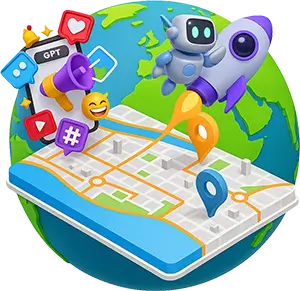Maximizing Efficiency: The AI for Productivity Revolution and What’s Next
The world of business is in the midst of a seismic shift, and artificial intelligence (AI) is at the heart of this transformation. With relentless advancements in technology, AI has redefined what productivity means for professionals, e-commerce operators, and organizations across the globe. This isn’t just a trend — it’s a revolution. If you’re a forward-thinking entrepreneur or decision-maker, leveraging AI to maximize efficiency could be the game-changing strategy your business needs to not only survive but thrive.
Artificial intelligence has done what seemed impossible just a few years ago: democratizing access to tools that optimize daily workflows, automate repetitive tasks, and deliver cutting-edge data insights. Are you prepared to step into the future and unlock unparalleled opportunities for growth? Discover how you can ride the AI productivity wave to stay ahead of the curve, while learning actionable tips to implement AI solutions that genuinely add value to your business processes.
The AI Productivity Revolution: How We Got Here
AI’s impact on productivity is nothing short of revolutionary, but it’s worth understanding how we arrived at this moment. Historically, every major technological breakthrough — from the invention of the assembly line to the rise of the internet — altered how work was done, yielding exponential gains in efficiency and scale. AI, however, isn’t just adding to this history; it’s rewriting it.
Unlike traditional productivity tools that simply assist with human efforts, AI automates and augments them. From hyper-efficient scheduling assistants to predictive analytics tools capable of uncovering trends no human could spot, businesses now have an unprecedented arsenal of tools at their disposal. But the shift isn’t solely about technology; it’s about empowerment. Entrepreneurs and professionals now have the means to transform their workflows, giving them time to focus on creativity, strategy, and innovation.
Consider this: a recent report by McKinsey highlights that companies leveraging AI across business functions report an average 20–30% increase in productivity. In practical terms, this might mean completing tasks in minutes that once took hours. Whether it’s automating email campaigns, generating reports, or managing customer inquiries via chatbots, the efficiency gains are undeniable.
Transforming Workflows: Real-World Examples of AI in Business
For many decision-makers, one of the biggest questions is, “How does AI truly fit into my business?” To answer that, let’s explore some real-world scenarios where AI is driving measurable results:
1. Sales Automation and Lead Generation
AI tools like HubSpot and Salesforce Einstein are revolutionizing how companies manage their sales pipelines. Through predictive lead scoring, these platforms identify high-value prospects based on behavior and historical data. Entrepreneurs no longer waste time chasing cold leads — they’re focusing their efforts where it matters most.
Example: A mid-sized e-commerce company implemented an AI sales assistant, which suggested personalized email templates for hesitant buyers. Within three months, their sales conversion rate increased by 15%.
2. Smarter Customer Service with AI Chatbots
Chatbots powered by AI are transforming customer interaction. Tools like Ada and Intercom respond to inquiries instantly, resolve common issues, and hand off complex problems to human agents when necessary.
Example: A small SaaS startup deployed an AI-driven chatbot for 24/7 support. Not only did customer satisfaction scores rise by 20%, but the human support team saved 30 hours per month — time they now use for direct customer engagement.
3. Precision-Driven Marketing Campaigns
Marketers are embracing AI to analyze campaign performance, optimize ad placements, and hyper-target audiences. Platforms like SEMrush and Phrasee allow businesses to create high-performing copy, predict A/B test winners, and stretch their ad budgets further than ever before.
Example: A clothing retailer used AI tools to segment customers based on past purchases and send them tailored promotions. The result? A 25% increase in return customers within six months.
4. Productivity Boosts with AI-Powered Scheduling
Remember those tedious hours spent juggling schedules? AI assistants like Clara and Clockwise handle meeting scheduling, align team availability, and even reorganize calendars to minimize time wastage.
Example: A CEO of a startup saved 10 hours a week in planning time after fully integrating an AI-powered scheduling assistant into their workflow.
The Strategic Roadmap: Adopting AI for Maximum Impact
While the possibilities are exciting, implementing AI effectively requires thoughtful planning. Here’s your roadmap to seamlessly adopt AI into your business practices:
Step 1: Identify Pain Points
Start by examining your operations for bottlenecks. Are time-intensive manual tasks slowing team productivity? Are you struggling with handling large datasets to make decisions? Pinpoint where AI can address your most pressing challenges.
Step 2: Select the Right AI Tools
It’s essential to choose tools that align with your needs. For small businesses, scalable tools like Notion or Grammarly can optimize daily tasks affordably. Larger enterprises may benefit from sophisticated platforms like Oracle AI or IBM Watson.
Step 3: Integrate Gradually
Adopting AI doesn’t mean rushing to overhaul every system overnight. Introduce tools one at a time, ensuring employees are trained and workflows are adjusted as necessary. Monitor key metrics such as time saved, revenue increase, or customer satisfaction as you implement.
Step 4: Balance Automation and Human Oversight
AI is powerful, but it’s not infallible. For example, an automated email campaign might miss personalization nuances without human review. Strive for a hybrid model where automation enhances human insight, without replacing it entirely.
Step 5: Track and Optimize
AI implementation isn’t a “set it and forget it” process. Continuously review performance and feedback from your team and customers to refine how AI fits into your operations.
GPT Tips: Unlock AI’s Full Potential Today
If you’re using GPT-based tools like ChatGPT to amplify productivity in your business, here are some practical hacks to extract maximum value.
1. Define Your Goals Precisely
Whether writing marketing copy or brainstorming ideas, prompt GPT with clear objectives. For example:
- Instead of: “Help me with marketing.”
Use: “Generate an email campaign promoting our new subscription model to small businesses, including benefit-oriented subject lines.”
2. Refine Outputs with Iterative Prompts
Don’t stop at the first response. Use follow-up instructions to hone GPT’s output:
- “Can you make the tone more professional?”
- “Now rewrite that email to appeal to a younger demographic.”
3. Automate Routine Tasks
Integrate GPT into workflows for recurring jobs like:
- Drafting blog post outlines
- Generating personalized message templates for leads
- Summarizing lengthy reports for team meetings
4. Leverage Industry-Specific Context
GPT can shine when tailored to your niche. Input industry-specific terminology and examples so the tool generates on-point insights.
- Example: “Write a product description for an AI scheduling app aimed at HR professionals.”
5. Collaborate, Don’t Delegate
Remember, GPT works best as a collaborative tool. Pair its suggestions with your expertise to produce stellar results that resonate with your audience.
The Future of AI and Why You Must Act Now
Businesses that embrace AI today are not only seizing competitive advantages but also setting the stage for long-term success. From automating mundane workflows to driving data-driven decisions, AI allows professionals to work smarter, not harder. However, the greatest power lies in how AI enhances human creativity, freeing up valuable time to focus on what truly matters: innovation, connection, and growth.
Now is the time to act. Waiting too long risks falling behind competitors who’ve already adopted a mindset of continuous innovation using AI. By taking even small steps — like integrating GPT-based tools into your content operations — you’re building a more resilient, future-proof organization.
Related Tags
#AIProductivity #BusinessAutomation #SalesAI #GPTTips #AIinMarketing #EfficiencyTools #AIforEntrepreneurs
Meta Description
Discover how AI is transforming productivity for businesses! Learn actionable insights, real-world examples, and GPT tips to amplify efficiency today.










0 Comments